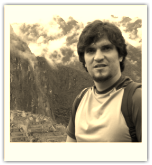Scientists
Dr Luiz Aragãois a data scientist with a PhD in biology (2011). Has a wide research interests, but current research questions are: Can airborne spectroscopy from an unmanned aerial vehicle (UAV) adequately characterize canopy chemistry? Are ecosystem biogeochemical flows in plant matter identifiable in the hyperspectral images? To what extent can hyperspectral data of canopies be used to estimate biomass production and storage in intact versus regenerating vegetation? In a larger context, these questions are designed to bring informations about the consequences of global changes on the ecosystem services provided to humanity by tropical forests.
Research: Functional diversity of intact and regenerating Amazon, Atlantic, and Cerrado systems using hyperspectral imagery (Fapesp 2015/50484-0). CNPq Lattes CV: lattes.cnpq.br/8368436696182107 Dr Luiz Aragão
Is the leader of the TREES lab. He has a background in Environmental Sciences from the State University of North Fluminense in Brazil with a PhD in Remote Sensing from the Brazilian Institute for Space Research (2004). Dr Aragão was a visiting student at the University of Edinburgh, UK (2003) and a Postdoc at the University of Oxford, UK (2004-2008). He is currently associated to the University of Exeter, UK as a Senior Lecturer and is a full-time Scientist at the National Institute for Space Research (INPE). He is an Associated Editor of the journals Plant Ecology and Diversity and Journal of Ecosystems. He also serves as reviewer for renowned journals such as: Nature, Science, PLOS One, Proceedings of the National Academy of Sciences, USA, Nature Climate Change, Philosophical Transactions of the Royal Society, among others. Dr Aragão has published as first author in the journals Nature and Science. He is an expert in tropical ecosystems and environmental sciences using Remote Sensing and his research focus on: carbon dynamics in forest ecosystems, climate and environmental change, ecosystem ecology and remote sensing of forest disturbances, including deforestation and fires. ** 7712 Google Scholar citations, h-index: 43, i10-index: 80** (04 Jan 2018). CNPq Lattes CV: lattes.cnpq.br/5174466549126882 
Dr Egídio Arai
has a background in Data Processing from Taubaté University, Brazil, with a Master in Apply Computer Sciences and a PhD in Remote Sensing (2011), both from the Brazilian Institute for Space Research, Brazil. Dr Arai is currently a Senior Technologist at the Brazilian Institute for Space Research. His research in Computers Sciences encompass a wide range of applications: Using satellites for meteorological analyses, computer systems, analysis of SeaWifs data and manipulation of HDF files. ** 1516 Google Scholar citations, h-index: 13, i10-index: 16** (04 Jan 2018). CNPq Lattes CV: lattes.cnpq.br/0049390900009593 |

Dr Liana O. Anderson
www.liana-anderson.org is a biologist, with a DPhil in Geography and the Environment from Oxford University (2006-2011) and a Postdoc from the Environmental Change Institute (ECI) at the University of Oxford (2011-2014). Works as researcher at the National Center for Monitoring and Early Warning of Natural Disasters (CEMADEN) in Brazil. Current research is focused on assessment of risk and impacts of droughts in Amazonia. My research aims to understand the hazards, vulnerabilities and direct and indirect wildfires impacts in Amazonian ecosystems, landscapes and population for subsidizing decision making. ** 4139 Google Scholar citations, h-index: 27, i10-index: 45** (04 Jan 2018). CNPq Lattes CV: lattes.cnpq.br/7834780583735756 
Dr Yosio Shimabukuro
has a background in Forest Engineering from the Federal Rural University of Rio de Janeiro. Dr Shimabukuro has a Master degree in Remote Sensing from INPE and a PhD in Remote Sensing/Forestry Sciences from Colorado State University, USA (1987). He has a post-doc from NASA Goddard Space Flight Center (1993) and is currently a Senior Scientist at INPE's Remote Sensing Division. Dr Shimabukuro carried out pioneering research on the development of the spectral linear mixing model applied to remote sensing data and was also the precursor of the methodologies utilized in the PRODES digital and DETER projects at INPE and FRA 2010 from FAO. He is and Associated Editor of the journals CERES and Ambiente e Água. Is a member of the Executive Board of the Brazilian Journal of Cartography. His research focus on forestry resources and forest engineering emphasizing the applications on nature conservation, remote sensing, geoprocessing, forest engineering and environmental sciences. ** 9729 Google Scholar citations, h-index: 47, i10-index: 152** (04 Jan 2018). CNPq Lattes CV: lattes.cnpq.br/1913003589198061 |
Postdocs

Dr Fabien Wagner
is a data scientist with a PhD in biology (2011). Has a wide research interests, but current research questions are: Can airborne spectroscopy from an unmanned aerial vehicle (UAV) adequately characterize canopy chemistry? Are ecosystem biogeochemical flows in plant matter identifiable in the hyperspectral images? To what extent can hyperspectral data of canopies be used to estimate biomass production and storage in intact versus regenerating vegetation? In a larger context, these questions are designed to bring informations about the consequences of global changes on the ecosystem services provided to humanity by tropical forests. Research: Functional diversity of intact and regenerating Amazon, Atlantic, and Cerrado systems using hyperspectral imagery (Fapesp 2015/50484-0). CNPq Lattes CV: lattes.cnpq.br/8368436696182107 |
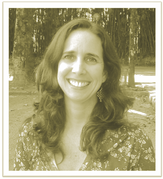
Dr Marisa Fonseca
has a background in Biological Sciences, Master (2001) and PhD degree in Plant Biology (2007) from the University of Campinas (UNICAMP), in Brazil. She is an expert in plant ecology and in land-use land-cover change and her present research focus on modeling current and future fire probability in the Brazilian Amazon using an innovative combination of climatic and land-use variables and the Maximum Entropy method. Research: Modeling fire probability in the Brazilian Amazon using the Maximum Entropy method. CNPq Lattes CV: lattes.cnpq.br/7961155188651740 |

Dr André Lima
has a background in Geography from the State University of Londrina, Brazil, a Master and PhD (2013) degree in Remote Sensing from INPE. His research focus on Geosciences, specifically linked to remote sensing of tropical forests. His work spans from land cover detection in Amazonia and landscape ecology to biodiversity conservation. 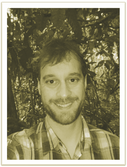
Dr Matheus Pinheiro Ferreira
received B.S. degree in forest engineering from the Federal University of Paraná, Curitiba, Brazil, in 2010, M.S. and PhD degree in remote sensing from the National Institute for Space Research (INPE), São José dos Campos, Brazil. His scientific research focuses on hyperspectral remote sensing of vegetation, including species identification, canopy chemistry, radiative transfer modeling and field spectroscopy. Research: Measuring and mapping Atlantic Forest canopy foliar traits with hyperspectral images and radiative transfer modeling. CNPQ Lattes CV: lattes.cnpq.br/9686528152912455 |
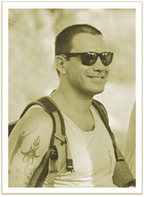
Dr Rodrigo Borrego Lorena
has a background in Geography from the State University of São Paulo (UNESP) with a Master degree (2001) in Remote Sensing from the Brazilian Institute for Space Research and a PhD in Geoscience (2008) from the University Catholic of Louvain, Belgium. He was director of research at the Jones dos Santos Neves Institute and Executive Secretary of the State Forum on Climate Change of the Espírito Santo State where he coordinated the creation of state policy on climate change and also the State Inventory of Greenhouse Gases. Research: Modeling of gross carbon emissions from forest fires in the Amazon. CNPQ Lattes CV: lattes.cnpq.br/0476041655115878 |
PhD Students

Gabriel Bertani
has a background in Forestry Engineering from the Federal University of Santa Maria (UFSM) in Brazil with a Master in Remote Sensing from the Brazilian Institute for Space Research (2014). He is a PhD student at the Brazilian Institute for Space Research. His interests include research on vegetation seasonality, temporal series analysis and chlorophyll fluorescence obtained by satellite sensors. Research: Analyze the dependence of photosynthesis seasonality on climate in Amazonia. CNPq Lattes CV: lattes.cnpq.br/9850106936806089 
Kaio Allan Cruz Gasparini
is a Forestry Engineer at the Federal Rural University of Rio de Janeiro - UFRRJ (2012), MSc in Forestry Sciences (2014) at the Agricultural Sciences Center of the Federal University of Espírito Santo - CCA / UFES, with a research on Environment and Water Resources. PhD student in Remote Sensing at the National Institute of Space Research - INPE. Has experience in the area of Geoprocessing with a multi-purpose cadastre in the Department of Integrated Management of Space Control, linked to the Department of Planning of the City Hall of Linhares-ES. Currently, work with mapping of degraded forests with high resolution images and the existing relationships between loss vs biomass gain in the temporal domain. Research: Development of a methodological approach for mapping and monitoring forest degraded areas due to selective logging and forest fires. CNPq Lattes CV: lattes.cnpq.br/4820170092915071 Catherine Torres de Almeida
is a Forestry Engineer (UFRRJ-Brazil, with a period at the University of Lleida-Spain) and Biologist (UERJ-Brazil). Has a master’s degree in Environmental and Forestry Sciences (UFRRJ-Brazil). As part of her Ph.D. in Remote Sensing at the Brazilian Institute for Space Research (INPE), she is evaluating the integration of LiDAR and hyperspectral remote sensing for estimating biomass and biodiversity on the Amazon Basin. Research: Hyperspectral and LiDAR remote sensing for the study of the biodiversity, phenology and carbon stock of the Amazon forest canopy CNPq Lattes CV: lattes.cnpq.br/5534145837431294 Ricardo Dal'Agnol da Silva
is an Environmental Engineer (2007-2011), Master in Remote Sensing from the Brazilian National Institute for Space Research (INPE, 2012-2014), and currently is a PhD student in Remote Sensing in INPE (2016-). His research is focused on forest and carbon dynamics and tropical forest ecology studies, mainly in Amazon forests, integrating field observations and remote sensing data. He is currently investigating tree mortality processes in Amazonia in different spatio-temporal scales using inventory plots, airborne LiDAR, optical very high resolution imagery, and Landsat and MODIS/MAIAC time series. Research: Assessment of climate change impacts on the biomass and carbon dynamics in the Amazon (Fapesp grant 2015/22987-7) CNPq Lattes CV: lattes.cnpq.br/6150479997891841 
Debora Cristina Cantador
has a background in Geography from the Federal University of Santa Catarina (UFSC) with a Master Degree in Geography from the State University of Campinas (UNICAMP). She is currently PhD student in Remote Sensing from the National Institute for Space Research in Brazil. Research: The aim of my research is to verify the impact the change of the land use and land cover in the water resources, in the Atlantic Forest. For this, use the hydrologic modeling, specifically the model Soil Water Assessment Toll (SWAT), this is used for predict the effects the land use and management the production of sediments, water and chemicals in the watershed. CNPq Lattes CV: lattes.cnpq.br/1657463280361794 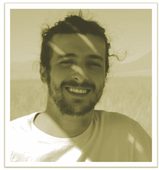
Henrique Luis Godinho Cassol
has graduated in Forest Engineer at University of Santa Maria, Brazil (2010), Master degree in Remote Sensing at University of Rio Grande do Sul, Brazil (2013) and PhD in Remote Sensing at National Institute for Space Research, INPE, Brazil (2017). Research: The aim of my research is to improve the biomass estimate in Secondary Forests from the Brazilian Amazon, using multi source data as Radar systems, optics, GIS and field data. He also has experience in forest inventories in the main Brazilian Biomas. He was consultant of revegetation projects for carbon estimate in context of the REDD, and consultant of forest restoration project at Atlantic Forest. CNPq Lattes CV: lattes.cnpq.br/1810929584104118 
Letícia d'Agosto Miguel Fonseca
is a Geographer graduated by Federal University of Juiz de Fora, has Master's degree in Soils and Plant Nutrition at Federal University of Viçosa (UFV), and is currently on Ph.D in Earth System Science at the National Institute of Space Research (INPE) (2015-). Worked as a Junior Researcher at the Brazilian Agricultural Research Corporation (EMBRAPA) in the sector of Agribusiness / Geoprocessing, performing researches involving remote sensing in the agricultural context. Has experience in soil characterization, potential erosion and spatialization of these data employing geoprocessing and geostatistics analysis. Research: Phenology of a seasonal floodplain area over savanna vegetation within the transition zone of the forest-savanna in Amazonia (FAPESP Project Number 2013/50531-2). I'm working with remote sensing data, coupling soil and plant data obtained from field campaigns and eddy flux tower measurements from the Large Scale Atmosphere-Biosphere Experiment (LBA). CNPq Lattes CV: lattes.cnpq.br/4738631288685838 |

Felix Ike
PhD, University of Exeter Research title: "Impact of climate and human-induced changes on the dynamics of Nigerian forests using Remote Sensing" Supervisors: Dr. Luiz Aragao and Dr. Lina Mercado Aims: My PhD research focus is on: 1. Enhanced Multi-criteria modelling of Tropical Deforestation using Remote Sensing 2. Evaluation of Vegetation Phenology and Land Use/ cover change in relation to long and (or) abrupt change(s) in precipitation and temperature 3. Ecocline Dynamics and Forest Fires. I am also involved in the spatial and temporal evaluation of biomass data at The University of Exeter Carbon Observatory. Profile: My early education was in Nigeria. I obtained BSc in Geography and Planning from Abia State University, Uturu, as departmental Best Graduating Student. I was retained by Abia State University after my National Youth Service (NYSC) as Graduate Assistant and taught undergraduate courses in Tropical Climatology, Geographic Information System, Applied Tropical Climatology and Atmospheric Resource Management. I obtained Master of Science (Distinction) in Climatology as Best Graduating student, Faculty of Environmental Science. I was awarded an ETF/Nigeria scholarship in November 2011 to study PhD in Physical Geography at Exeter University. 
Imogen Fletcher
PhD, University of Exeter, UK Research title: "Modelling and Quantifying Net Carbon Emissions from Forest Fires in Amazonia" Supervisors: Pierre Friedlingstein and Dr. Luiz Aragao. Aims: The aim of my research is to improve the way tropical fires are modelled in DGVMs. Existing fire models perform inadequately when predicting fires in tropical regions, due to the difficulties in modelling human ignitions, and yet these fires can have a potentially huge impact on the global climate, since large volumes of carbon are stored as forest biomass. Improving the way these fires are modelled should therefore improve our understanding of the impact of tropical fires on the climate. 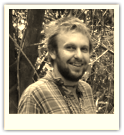
Simon Buckley
PhD, University of Exeter 
Diego Alejandro Navarrete Encinales
PhD, University of Exeter |
Master Students

Celso H. L. Silva Junior
is an Environmental Engineer, specialist in Geoprocessing. Currently studying Master’s Degree in Remote Sensing at the National Institute for Space Research - INPE, where he studies the impact of forest fragmentation on the carbon stocks of the Amazon Basin. His main interests are: Land Use and Land Cover Dynamics, Fire Dynamics in Tropical Ecosystems, Environmental Changes in the Tropics, Carbon Dynamics and Remote Sensing of Vegetation. Research: Impact of Forest Fragmentation in the Amazon Basin Carbon Stocks - A Remote Sensing Approach. CNPq Lattes CV: lattes.cnpq.br/0506851271452550 |

Laís Fernandes de Souza Neves
has a background in Geography fromthe State University of Mato Grosso (UNEMAT), Brazil. She is currently coursing a Master Degree in Environmental Sciences at UNEMAT, with co-supervision from Dr Liana Anderson, with a Dissertation entitled " Evaluation of spatio-temporal fire dynamics and their impacts on land cover in the Araguaia/MT State park". |
Research Assistants

Ana Carolina M. Pessôa
holds a degree in Biological Sciences – Ecology from Federal University of Rio de Janeiro (UFRJ). She was an exchange student at University of Montana – USA through the Brazilian program ‘Science Without Borders’. She earned her Master’s degree in Remote Sensing from National Institute for Space Research (INPE) in 2016. Currently, works on the project ‘Tropical Deforestation and Economic Development’ (Research project – KLIMAFORSK, Norwegian Research Council – Project No: 230860/F10). The project is headed by Dr. Torfinn Harding and Dra. Liana Anderson. Her research interests includes forest ecology and environmental conservation, focusing on Protected Areas issues. Research: Redução de impactos ambientais através de incentivos financeiros e políticas de regulação do uso da terra: evidências dos incêndios florestais na Amazônia Legal. CNPq Lattes CV: lattes.cnpq.br/9352090361680792 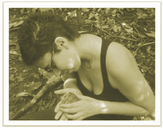
Monique Rodrigues da Silva Andrade Maia
have a degree in Marine Biology (2008-2011), specialization (2012-2013) in Geoprocessing and GIS in the Laboratory of Conservation Ecology (LEEC / UNESP-RIO CLARO), master's degree (2013-2015) in Ecology at National Research Institute of Amazonia (INPA-Manaus), research fellowship (2015-2018) INPA and National Institute of Space Research (INPE). Research: Creating A Definite Database For Amazon Soils: Multifunction Data Integration And Analysis Of Pedogenetic Processes. CNPq Lattes CV: lattes.cnpq.br/2373280617888834 
Laura B. Vedovato
has a Bachelor´s degree in Ecology from State University of São Paulo - UNESP and Master´s degree in Remote Sensing from the Brazilian Institute for Space Research- INPE (2016). Research: Spatio-temporal analysis of forest fragmentation in the Brazilian Amazon. CNPq Lattes CV: lattes.cnpq.br/6369586960877583 
Sacha M. O. Siani
holds Master’s degree in Remote Sensing from National Institute for Space Research, Brazil (2016) and bachelor’s degree in Environmental and Sanitary Engineering from University of Taubaté (2012). His research focuses on socioenvironmental issues and conservation policies, using geoinformation, remote sensing, spatial analysis and econometrics. Currently, Sacha works on the project ‘Tropical Deforestation and Economic Development’ (Research project – KLIMAFORSK, Norwegian Research Council – Project No: 230860/F10). The project is headed by Dr. Torfinn Harding and Dra. Liana Anderson. Research: Tropical Deforestation and Economic Development (Project No: 230860/F10) CNPq Lattes CV: lattes.cnpq.br/4266005890551672 
Thais Michele Rosan
has a Msc in Remote Sensing from the Brazilian Institute for Space Research (2017) and degree in Geography from Sao Paulo State University (2014). Research interested: tropical ecosystem, environmental change, forest degradation, fire dynamic and land-use land-cover change. Research: Landscape characterization the functional diversity in Brazilian biomes based on hyperspectral images. (FAPESP Project No: 17/09353-4) CNPq Lattes CV: lattes.cnpq.br/4442882371327272 |

Leticia Kirsten Fernandes
has a background in Forest Engeneering from the State University of Mato Grosso (UNEMAT), Brazil 
Luaê Andere is a technitian in remote sensing and GIS.

Camila Valéria de Jesus Silva has a background in Forest Engeneering from the Federal University of Brasília (UNB), Brazil and a Master (2014) degree in Remote Sensing from INPE.

Brenda Neiva Duarte has a background in Biology from Taubaté University and is technician in remote sensing and GIS.
|

